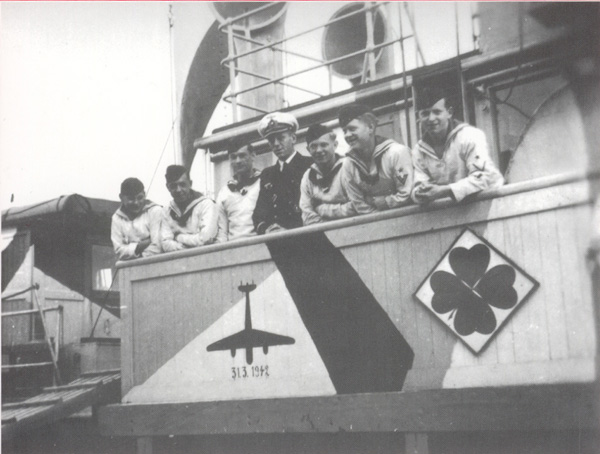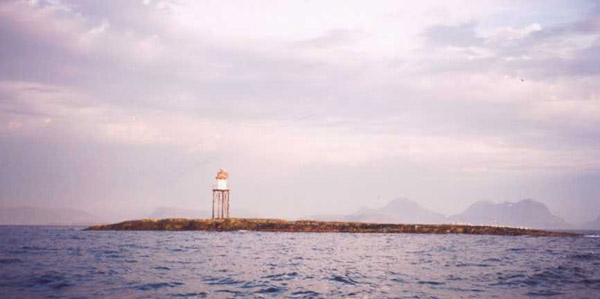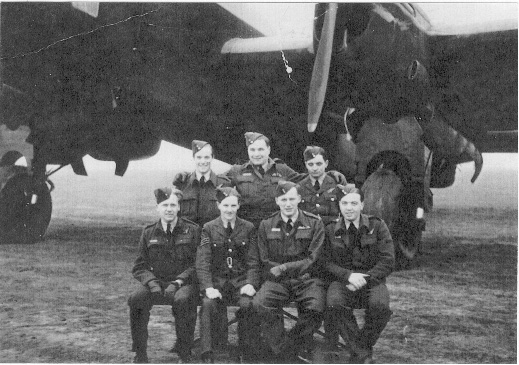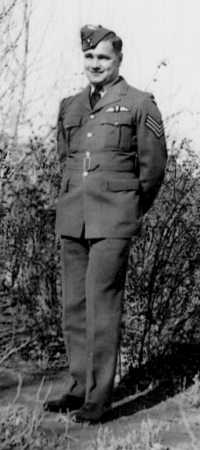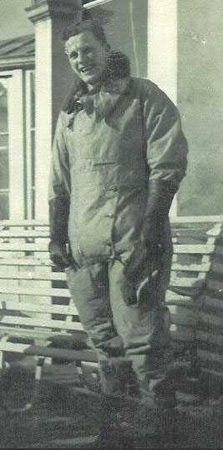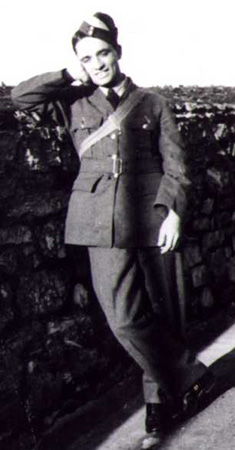W1015 TL-P from 35 Squadron
|
On 30th March 1942, the crew of Halifax W1015 TL-P from 35 Squadron took off at 1902 hrs from RAF Kinloss on the North East Coast of Scotland to participate in an attack on the German Battleship Tirpitz which was moored at the time in Fættenfjord in Norway. The RAF Operations Record Book states only that the aircraft failed to return. However, further investigations have revealed some of the details about what happened to the aircraft after leaving Kinloss. It is likely that this aircraft was en route to the Tirpitz in Fættenfjord when it was shot down with the loss of all onboard. |
|
Rank
|
Name
|
Force | Crew Position | Age |
Home Town
|
Fate |
| F/sgt | STEINHAUER G H | RCAF | Pilot | 22 | Morse, Saskatchewan, Canada | Died |
| P/O | BROWN P G | RAFVR | 2nd Pilot | 21 | Whalley Range, Manchester, England | Died |
| F/Sgt | GOODRUM L E | RAFVR | Navigator | 23 | Little Thurrock, Essex, England | Died |
| Sgt | MEADE E T | RAFVR | W/Op Air Gunner | 22 | Finchley, Middlesex, England | Died |
| Sgt | CAMPBELL D G J | RAFVR | W/Op Air Gunner | 20 | Kingsbury, Middlesex, England | Died |
| Sgt | COWAN/COHEN M | RAF | Tail Gunner | 23 | Edgeware, Middlesex, England | Died |
| Sgt | DUNLOP J B | RAF | Flight Engineer | 22 | Callander, Perthshire, Scotland | Died |
| The bodies of F/Sgt Steinhauer, P/O Brown, Sgt Meade and Sgt Cowan/Cohen were recovered and are buried in Trondheim (Stavne) Cemetery, Norway. The rest of the crew were never found and are commemorated on the Runnymede Memorial, Surrey, England.
Locals report that the weather in the evening was fine with a full moon. At Tyrhaug lighthouse, near Edøy, the sons of the lighthouse watchman, Sjøsæther, were tying their boat up for the night. Ole Sjøsæther said that the two brothers talked about how the conditions that evening would be good for aircraft activity. Shortly after this they observed flashes of light and the sound of aircraft engines coming from the direction of Kristiansund, heavy bombers then flew over them travelling in a northerly direction. Ole said that the aircraft were fired at by the German defences on Edøy. Bullets landed near the lighthouse, and also splashed in the water near the boat. Bombs were falling around the boats in the harbour at this time too. They missed the boats, but alarmed the crew of the vessel "Vaagan" from Vesterålske so that they left the vessel and spent the night ashore at Steinshavn.
The lights in the Tyrhaug lighthouse had to be checked regularly to ensure that they stayed alight, and when Ole Sjøsæther went out later that evening to check them he could still hear the sound of aircraft. Suddenly, he heard and explosion, and saw a flash of light coming from the direction north of Remmingen. Locals who lived in Remmingen at the time saw a large aircraft pass over them heading in a northerly direction, and then heard an explosion. A German frontline AA boat by the name of 'Sachse' which was part of the harbour protection squadron from Molde, filed a report on March 31st 1942. The report said that there was an aircraft alarm at 2235 hrs on March 30th, and at the time the vessel was in a position in the southern part of Griphölen, between the lighthouses Gjöslingskjaer and Langholmene. At 2240 hrs heavy anti-aircraft fire was seen above Kristiansund N, and five aircraft were observed flying together over the sea and along the coast heading for Trondheim. "Sachse" fired at two of the aircraft, and then the guns at Edö (H.K.B. 7/571) took over. No hits were observed on the aircraft. Between 2300 and 0000 hrs heavy anti-aircraft fire was observed above Kristiansund N, and aircraft were seen circling above the area. At the same time, bombs were observed being dropped twice in the southern part of Kristiansund N. Ten minutes later, two further bombs were seen and heard to explode in the direction of Hestkjaer and Kvitholmen lighthouses. Afterwards, two aircraft flew one behind the other towards Kristiansund N and were met with heavy anti-aircraft fire from a northern direction where "Sachse" was situated. The first aircraft came in from the port side, and fire was opened on it from a distance of about 600 meters. As a result, the aircraft turned and banked away sharply then flew off towards the north west. The second aircraft came in from the starboard side of "Sachse", and the vessel opened fire on it from a distance of around 500 meters. Judging the aircraft's flight path and speed of travel, the crew of "Sachse" aimed their fire so that it was just ahead of where the aircraft would be, thus, the aircraft flew into the line of fire from both 2cm guns and was hit in the fuselage and the wings. Five minutes later an impact was observed causing a large fire in a northerly direction, apparently on Smöla. "Sachse" later reported that a total of 209 20mm grenades, and 315 machine gun bullets had been fired towards the aircraft. In fact, the aircraft had crashed on a skerry called Remmingskjæret (between the islands of Smøla and Edøy) which is about 60 meters long and 20 meters wide with a navigation light on the top.
An incendiary device was observed over the sea at about 2330 hrs in the direction of Kvitholmen, followed by a crash and fire from the same direction around about 2340 hrs. The German observation base in Kristiansund also had a report on the night of 30/31 March 1942. It said that at approximately 0045 hrs on the 31 March what appeared to be a burning vessel was observed in the direction of Smøla. This information was received from the German front line vessel "Thüringen". The Norwegian fire rescue boat searched for the supposed vessel, but did not find anything. The following day, Norwegian police reported the discovery of the burnt out aircraft, along with three dead airmen. They reported that the men were badly burnt, and that one of them was in a blue battledress. At daybreak on Tuesday, March 31st, a fisherman from Glasøya was out in his boat fishing. He noticed that the skerry, Remmingskjæret, looked different from usual. Along with some others, he rowed out to the skerry to investigate, where they were met with a terrible sight. A large bomber had crashed there during the night. The skerry was almost covered with the hull of the aircraft, which appeared as if it had been coming from the south. All four engines were there, along with machine guns and lots of ammunition. There were twisted parts of the aircraft lying everywhere. Two dead airmen were still inside the hull. On the far end of the skerry, they found another dead airman lying on the rocks. The fishermen all remember that there was an indescribable smell on the skerry. Remarkably, the navigation light on the eastern side of the skerry was relatively undamaged, with only one window missing. During the day, many bullets that lay around the crash site went off due to the heat from the small fires that were still burning. One man told how he had discovered a parachute in the sea, with the body of an airman still attached to it. Possibly one of the crewmembers had been able to bail out before the aircraft crashed. The fishermen did not recover the bodies, and in the days after the crash, the weather was bad with heavy seas and winds from the north. Most of the wreck was washed off the skerry, and all but one body was washed away. The body of F/Sgt G Steinhauer was recovered from Remmingskjæret, and was buried at Trondheim (Stavne) Cemetery on 8th April 1942. On the same day, three airmen from another 35 Squadron Halifax, R9496 TL-L, Flight Sergeant Archibald, Sergeant McLaren and Sgt Francis were buried at Trondheim Stavne Cemetery along with Squadron Leader Webster from 10 Squadron, pilot of Halifax W1043 ZA-F also shot down on the night of 30/31st March 1942 in other parts of the area. The three bodies of airmen recovered from Halifax W1044 ZA-D, Pilot Officer Day, Sergeant May and Sergeant Richard were buried in the local cemetery at Heim on April 4th and after the war moved to Trondheim Stavne Cemetery. It was some time later before the other three bodies from W1015 TL-P, Pilot Officer Brown, Sergeant Meade and Sergeant Cohen, were again recovered from the sea, one at Remmingen, one at Hellesfjorden and another at Lauvøya later in 1942. They may have been buried locally initially, but all are now in Trondheim (Stavne) Cemetery. The bodies of F/Sgt Goodrum, Sgt Campbell and Sgt Dunlop were never found.
In the1970's divers discovered wreckage from Halifax W1015 TL-P on the seabed near the crashsite, including the four engines.
My special thanks to Morten Moe in Norway for his help in researching the loss of this aircraft. |
© Linzee Druce 2001-2012
